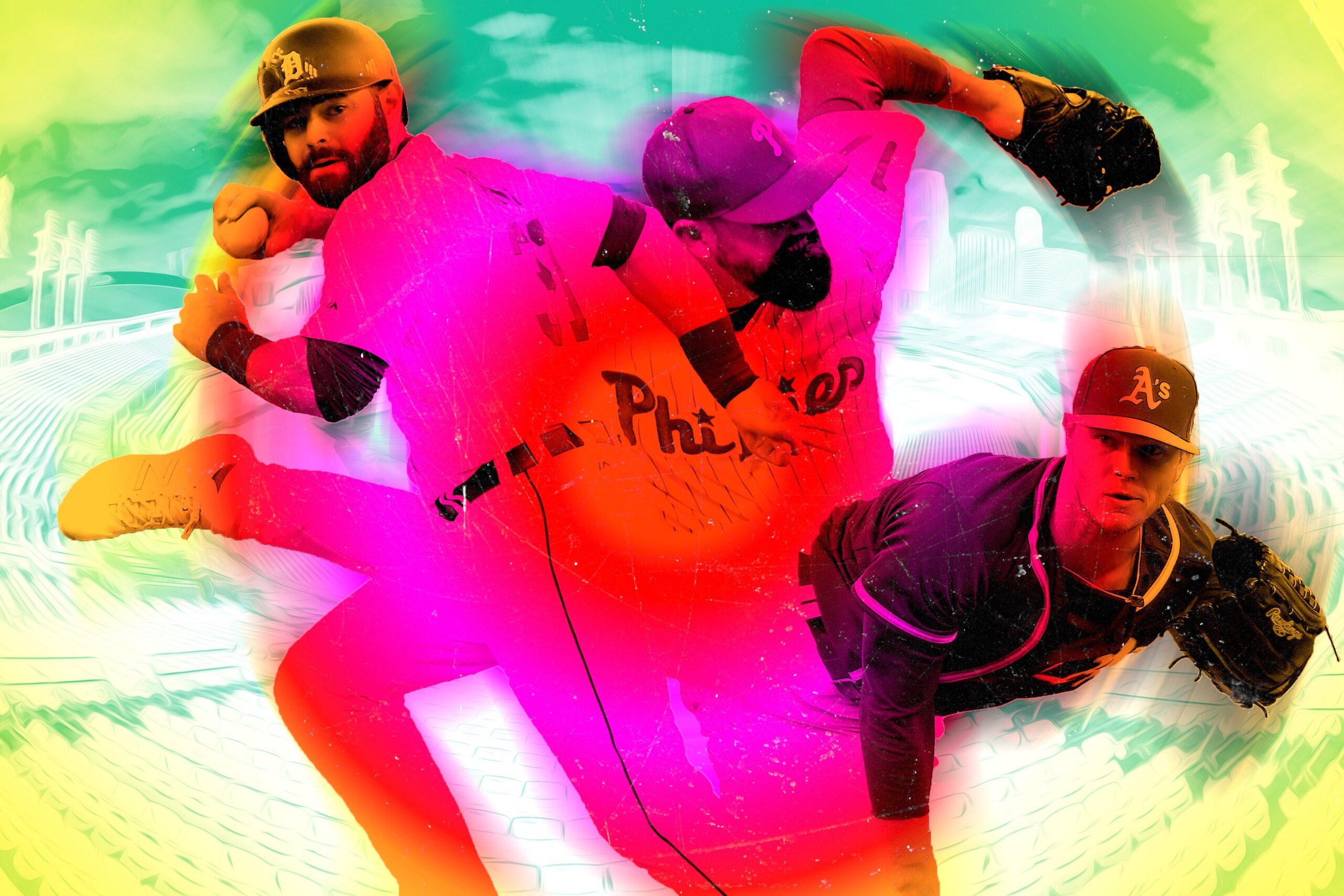
With nearly two weeks still to go until the 2017 trade deadline, MLB contenders have already started reinforcing the weakest points on their rosters. Last week, the Cubs traded for top-flight starter José Quintana; over the weekend, the Nationals added relievers Ryan Madson and Sean Doolittle; and on Tuesday, the Diamondbacks filled an outfield hole with J.D. Martinez while the Yankees acquired infielder Todd Frazier and relievers David Robertson and Tommy Kahnle.
Those teams might not be done dealing. Washington, for instance, would be wise to trade for another bullpen arm, as both Madson and Doolittle have extensive injury histories, and even if the new late-inning relievers remain healthy, the Nationals’ middle-inning corps is the same unreliable group that caused all the initial bullpen misery.
But at the very least, Washington can enter the stretch run knowing it addressed its greatest need. That’s more than can be said for some contenders (hello, Boston), who must make fixes before July 31 (or, in more complicated fashion, by the August 31 waiver deadline) or risk competing for a playoff spot with easily exploitable roster holes. Let’s survey the other top playoff hopefuls to identify their biggest needs at the deadline and possible options to sate them.
Red Sox: Third Baseman
The disastrous Pablo Sandoval experiment came to an official end on Wednesday, as the first-place Red Sox released the third baseman with more than two years remaining on his contract. Sandoval was one of the worst hitters in the majors in his time in Boston, and this year was more of the same, as he posted a 59 wRC+ — which is still better than the marks for Deven Marrero (46) and Josh Rutledge (49), the two other Red Sox with the most plate appearances at third this year.
Combined, Boston’s third basemen have been valued below replacement level, and they’ve collectively batted about as well as Reds slap hitter José Peraza. As I wrote at the end of May, the best replacement is already in Boston’s system, as 20-year-old Rafael Devers has spent the season affirming his worth as one of the best prospects in all of baseball. Since then, he finished up a stint at Double-A in which he hit .300/.369/.575 and started crushing Triple-A pitching, with a .467/.529/.733 in four games at that level.
But Boston’s brass continues to downplay the likelihood that Devers will receive an MLB promotion, suggesting that a deadline trade is inevitable. Two rumored possibilities have been removed this week, as Frazier went to the Yankees in a trade and Miami’s Martín Prado hit the disabled list with a knee sprain. Elsewhere, Pittsburgh’s David Freese and Oakland’s Jed Lowrie, who could shift from second base, are options, and one of the Mets’ fungible infielders — Asdrúbal Cabrera, Wilmer Flores, T.J. Rivera — could also function as a last resort.
Rays: Relief Pitcher
By almost any metric, the Rays’ bullpen has been a bottom-10 outfit this year. Only one bullpen has recorded more meltdowns; only two have a lower strikeout rate; and only four have a worse rest-of-season projection. Besides closer Alex Colomé, who leads the AL with 28 saves, the bullpen is, in typical Rays fashion, an inexpensive assortment of middling arms; the top setup man is Tommy Hunter, throwing for his fourth team in the past 24 months. Tampa Bay leads the AL wild-card race, but seven teams are within five games, so the Rays can ill afford more bullpen blowups down the stretch.
On Tuesday, the Rays made a minor move, sending the Braves cash considerations for Chaz Roe and his intriguing slider, but Roe has pitched only four minor league innings (and allowed nine earned runs) since early April after suffering a lat strain. He’s probably headed to Tampa Bay’s farm for now, and Tampa Bay could use a more reliable run-stopper in the late innings, anyway. Philadelphia’s Pat Neshek (1.17 ERA in 38.1 innings this year) and Pittsburgh’s Tony Watson (0.77 ERA over the past month) are both free agents after this season, meaning they shouldn’t cost much in a trade, and Detroit’s Justin Wilson is available, if at a higher price.
Indians: Starting Pitcher
It’s not easy to identify a large area of need for Cleveland, which despite a precarious situation in the standings — only a half-game lead over Minnesota in the AL Central — has a solid top-to-bottom lineup and boasts one of the majors’ best bullpens, plus a rotation that looks reliable as a whole. But that appearance is deceiving; beyond Corey Kluber and Carlos Carrasco, the starting staff gets dicey, fast. With a 2.73 ERA in 66 innings, Mike Clevinger has been Cleveland’s third-best starter this year, but his abnormal .230 BABIP and 83.1 percent strand rate suggest negative regression is coming for the second-year right-hander. The opposite holds true for the trio of Trevor Bauer, Josh Tomlin, and Danny Salazar, who all have pitched better than their surface stats indicate — but still, those surface stats are ugly: The best ERA in that group belongs to Salazar, at 5.40.
Cleveland doesn’t need a starter as urgently as Boston needs a third baseman or Tampa Bay needs a reliever, but if Salazar struggles in his return from a DL stint this weekend, another arm would certainly help. St. Louis’s Lance Lynn could make sense as a reliable arm, and a deal for Oakland’s Sonny Gray would fit with Cleveland’s recent trend of win-now moves. The team already tried winning a World Series with one effective starting pitcher last year; this time around, it might aim for a more balanced approach.
Astros: Another Corner Bat
It seems odd to suggest that Houston’s offense, which is on pace to score the most runs of any team in the past decade, has a route to improvement, but the Astros’ lineup could grow even more imposing. The immense talent at the top of Houston’s batting order masks the bottom’s struggles, leaving the Astros with an imbalanced lineup. Left fielder Nori Aoki isn’t reaching base or hitting for power, a combination that strands him with an 80 wRC+, and designated hitter Carlos Beltrán isn’t faring much better, with an 87 wRC+ that places him near the bottom of the DH leaderboard. With Carlos Correa out for the next six to eight weeks with a torn thumb ligament, an upgrade in a corner spot, where utility man Marwin González plays most frequently, would allow utility bat González to move full-time to short without leaving the team in danger of a domino effect elsewhere. Minor league outfielder Derek Fisher might be the answer, but Houston has enough positional versatility that a slugging first baseman (Oakland’s Yonder Alonso, perhaps) could pay dividends as well.
Houston also shouldn’t worry that adding a good hitter to an already great lineup would produce diminishing returns. As FanGraphs’ Dave Cameron explained two years ago when Toronto, then the league leader in runs scored, followed a similar course of bolstering a strength by trading for Troy Tulowitzki, “The whole really is greater than the sum of the individual parts, because good hitters create more opportunities for other good hitters to turn their production into runs. And because players tend to hit better with men on base than the bases empty, a good hitter can have a positive impact on his teammates’ performances as well.”
Brewers: Starting Pitcher
Milwaukee’s magic may be running out, as a four-game losing streak coupled with the Cubs’ recent winning binge has reduced the Brewers’ division lead to just 1.5 games. FanGraphs’ playoff odds give the Brewers just a 8.9 percent chance of winning the division and a 9.1 percent chance of catching either Arizona or Colorado for a wild-card berth. Still, Milwaukee has resided in first place, either tied or by itself, every day since May 26, and it hasn’t ceded enough ground to the Cubs to punt on the season entirely.
Milwaukee’s rotation is the positional grouping in greatest need of an upgrade. It consists of one effective pitcher who’s healthy (Jimmy Nelson), one effective pitcher who’s hurt (Chase Anderson), and a whole bunch of question marks. Like with the Red Sox’s third basemen, the Brewers’ staff embodies the maxim that a positional improvement from bad to decent is just as valuable as one from decent to good, and the former is often easier and cheaper to achieve, which also fits with Milwaukee’s current timeline and position on the win curve. The Brewers are reportedly the “most aggressive team pursuing” Sonny Gray, the best starter on the market unless the Rangers make Yu Darvish available. If Gray’s cost becomes prohibitive for a team that’s still probably a year or two away from its peak, a lesser option could come from Toronto’s stable of mid-rotation arms (Marco Estrada, J.A. Happ, and Francisco Liriano).
Rockies: Catcher
Colorado’s catchers have combined for a lower slugging percentage than their teammate Kyle Freeland has posted by himself. Freeland, of course, is a pitcher, and not even a particularly strong-hitting one. The backstops’ numbers look even worse when converted to park-adjusted figures to reflect the advantage they receive from playing half their games at Coors Field: They have combined for a wRC+ of 40, meaning they have hit 60 percent worse than a league-average hitter. Put another way, Colorado’s catchers have been as far below average as Joey Votto has been above average.
And those demerits are just on offense; the Rockies have also posted the second-worst framing numbers of any team. Because catchers must develop intimate knowledge of and working relationships with their pitchers, clubs are typically reluctant to add a catcher midseason, when that adjustment period is naturally truncated, and the Rockies might be especially resistant because they feature such a young staff. But the current crop isn’t doing that staff any favors, either via run support or framing assistance, and the situation is dire enough that defying that bit of baseball wisdom is warranted. The situation in the standings is growing more uncomfortable as well: While the Rockies are still a favorite to earn a wild-card berth, a prolonged slump has allowed the Brewers/Cubs division loser into the picture. Detroit’s Alex Avila (153 wRC+, tops among catchers, though an admittedly poor defender) is the Rockies’ best option if they decide to make a change.
Dodgers: Nothing
The best team in baseball has won 31 of 35 games, and while it’s poking around at players that could refine a roster that’s already a juggernaut — Baltimore closer Zach Britton would look fearsome pitching the eighth inning in front of Kenley Jansen — it doesn’t have any glaring needs.
A healthy Britton is a top-five reliever in the majors, but the Dodgers aren’t desperate for a lefty: The top southpaw in their bullpen is the unheralded Luis Avilán. But no matter: No relief corps has been stingier against left-handed hitters. Neither do they need a right-handed slugger, after the team’s longstanding struggles against lefty aces; between Justin Turner (now the best hitter in the majors against lefties), Chris Taylor, Logan Forsythe, and Austin Barnes, they have enough such bats. Nor must they add another outfielder, as Joc Pederson’s bat has heated up and Cody Bellinger continues to excel from all corners of the diamond.
L.A. might dip into its reserves of money and prospects to make a deal by the end of the month, but it’s already the World Series favorite regardless. As teams scramble over the next 12 days to patch weaknesses and strengthen their rosters, the Dodgers have the luxury of operating without any urgent holes to fill.
All stats besides team records are through Tuesday’s games.

